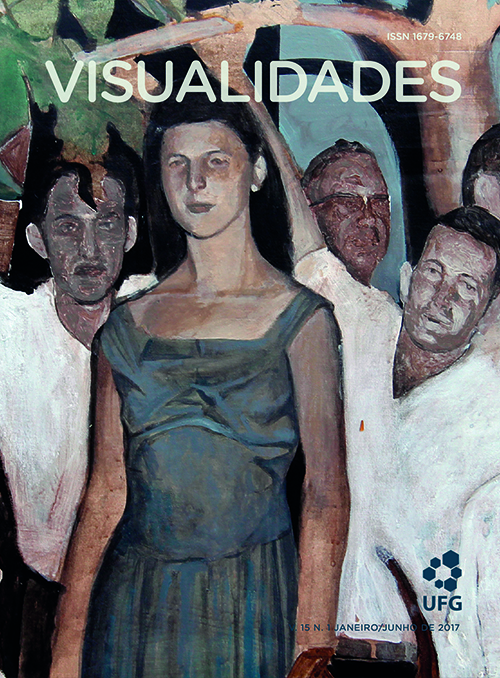Payasas mujeres y mujeres payaso: el travestismo en la payasaria
DOI:
https://doi.org/10.5216/vis.v15i1.48278Keywords:
Clownery, Female Comicality, TransvestismAbstract
The female clown is a recent figure in the history of the performing arts, and has gained space and visibility through a movement articulated around a category called "feminine comicality." In this context of vindication and visibility of women’s clown comedy, emerges several gender problems of this artistic community. This article addresses one of these problems: the transvestism of women in clownery. From a feminist-queer perspective, we have elaborated some questions about the performance of women in clownery, which can broaden the debate on the category of "feminine comicality" developed by women clowns in the last years.
Downloads
References
ARISTÓTELES. Poética. Madrid: Gredos, 1999.
BERTHOLD, Margot. História mundial do teatro. São Paulo: Perspectiva, 2001.
BUTLER, Judith. Cuerpos que importan: sobre los límites materiales y discursivos del sexo. Barcelona: Paidós, 2002.
CASE, Sue- Ellen. Feminism and theatre. Houndmills: Macmillan, 1988.
CASTRO, Alice Viveiros de. O elogio da bobagem: palhaços no Brasil e no mundo. Rio de Janeiro: Editora Família Bastos, 2005.
CONNOR, Catherine. Teatralidad y resistencia: el debate sobre la mujer vestida de hombre, en: Actas de XI Congreso de la Asociación Internacional de Hispanistas, 1994, pp. 139-145. Disponible en: <http://cvc.cervantes.es/literatura/aih/pdf/11/aih_11_3_016.pdf > Acceso en: 15 de julio de 2015.
DAVIS, Natalie Zemon. Women on top: symbolic sexual inversion and political disorder in early modern Europe, en: BABCOCK, Barbara y TURNER, Victor (Ed.) Reversible World: symbolic inversion in art and society (symbol, myth and ritual). Ithaca (NY), London: Cornell University Press, 1978.
FO, Dario. Manual mínimo do ator (3ª Ed.) São Paulo: Editora SENAC, 2004.
FRATELLINI, Annie. Destin de clown. Lyon: La Manufacture, 1989.
GAY, Jane de. Naming names: an overview of women in theatre, 1500–1900, en GOODMAN, Lizbeth y GAY, Jane de. The Routledge reader in gender and performance, 2002, pp. 25-28. London and New York: Routledge.
HALBERSTAM, Judith. Female masculinity. Durhan and London: Durk University Press, 1998.
HALBERSTAM, Judith y VOLCANO, Del LaGrace. The drag king book. London and New York: Serpent’s Tail, 1999.
HART, Linda y PHELAN, Peggy (Ed.) Acting Out: Feminist Performances. University of Michigan Press, 1983.
HOOKS, bell. Is Paris burning?, en: HOOKS, bell. Black looks: race and representation. Boston, Massachussets: South End Press, 1993.
HOROWITZ, Susan. Queens of comedy: Lucille Ball, Phyllis Diller, Carol Burnet, Joan Rivers, and the new generation of funny women. London and New York: Routledge, 2005.
JUNQUEIRA, Mariana Rabelo. Da graça ao riso: contribuições de uma palhaça sobre a palhaçaria feminina. TRabajo de máster del Programa , 2012.
NASCIMENTO, Elaine Cristina Maia. Comicidade feminina: as possibilidades de construção do cômico no trabalho de mulheres palhaças. Tesis de máster presentada al Programa de Pós-Graduación em Artes Escénicas – Escuela de Teatro, Escuela de Danza - Universidad Federal de Bahia, 2014.
MUÑOZ, José Estebán. Disidentifications: queers of colors and the performance of politics. Minneapolis, London: University of Minnesota Press, 1999.
NOCHLIN, Linda. Why have there been no great women artists?, en: VIVIAN GORNICK, Vivian y MORAN, Barbara K. Woman in sexist society: studies in power and powerlessness. New York: Basic Books, 1971.
POLLOCK, Griselda. Vision and difference: femininity, feminism and the history of art. London and New York: Routledge, 1988.
RICH, Adrienne. Compulsory Heterosexuality and Lesbian Existence, en Journal of Woman’s History, 15, 3, 2003, pp. 11-48.
ROWE, Kathleen. The unruly woman: gender and the genres of laughter. Austin: University of Texas Press, 1995.
SOLANAS, Valerie. SCUM Manifesto. 1967. Disponible en: <http://www.iztacala.unam.mx/errancia/v1/PDFS_1/POLIETICAS6_SCUMMANIFESTO.pdf> Acceso: 20 de mayo de 2013.
TOWSEN, John H. Clowns. New York: Hawthorn Books, 1976.
WITTIG, Monique. The straight mind and other essays. Boston: Beacon Press, 1992.
WITTIG, Monique. El pensamiento heterosexual y otros ensayos. Barcelona, Madrid: Egales, 2006.
Downloads
Published
How to Cite
Issue
Section
License

This work is licensed under a Creative Commons Attribution 4.0 International License .
Authors who publish in this journal agree to the following terms:
a. Authors retain the copyright and grant the journal the right of first publication, with the work simultaneously licensed under the Creative Commons Attribution 4.0 License which allows the sharing of work with acknowledgment of authorship and initial publication in this journal.
b. Authors are authorized to take additional contracts separately, for non-exclusive distribution of the version of the work published in this journal (eg publish in institutional repository or as a book chapter), with acknowledgment of authorship and initial publication in this journal.
c. Authors are allowed to publish and distribute their work online (eg in institutional repositories or on their personal page) after the initial publication in this journal, as this can generate productive changes, as well as increase the impact and citation of the published work ( See The Effect of Free Access).
Every effort has been made to identify and credit the rights holders of the published images. If you have rights to any of these images and have not been correctly identified, please contact the Visuals magazine and we will publish the correction in one of the next issues.






